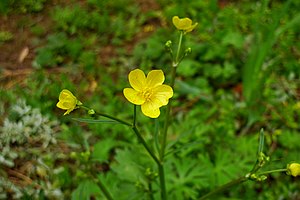Ranunculus californicus
| Ranunculus californicus | ||||||||||||
|---|---|---|---|---|---|---|---|---|---|---|---|---|

Ranunculus californicus |
||||||||||||
| Systematics | ||||||||||||
|
||||||||||||
| Scientific name | ||||||||||||
| Ranunculus californicus | ||||||||||||
| Benth. |
Ranunculus californicus is a species of the genus buttercup ( Ranunculus ) within the family of Ranunculaceae (Ranunculaceae).
description
The stems are erect or prostrate, wire-haired, curly-haired or hairless, not bulbous at the base and do not form roots at the nodes . The roots are not knotty. The leaf blade of the basal leaves is 1.8 to 5.8 × 2.3 to 7.6 centimeters in size, broadly ovate or heart-shaped and three-lobed, three-part or consisting of three leaflets. The leaflets or sections of the basal leaves are undivided or one to two-lobed or divided. The end sections are linear to circular. The leaf margins are serrated, notched or whole, the leaf tip pointed to rounded.
The flower base is bald or slightly stiff. The sepals are 4 to 8 × 2 to 4 millimeters in size, hairy and bent back 2 to 3 millimeters above the base. The 9 to 17 petals are (6) 7 to 14 × 2 to 6 millimeters in size and yellow. The head of the achenes is 3 to 7 × 4 to 9 millimeters in size and spherical or hemispherical. The achenes are 1.8 to 3.2 × 1.4 to 3.2 millimeters in size and hairless or rarely stiff-haired. Its edge forms a narrow rib 0.1 to 0.2 millimeters wide. The beak is 0.2 to 0.8 millimeters long, lanceolate and persistent.
Occurrence
Ranunculus californicus occurs in California and Oregon.
Systematics
Ranunculus californicus was first described by George Bentham in 1849 . There are two varieties:
- Ranunculus californicus var. Californicus : The nominate form has upright to lying, hairy or bald stems. The leaf blade of the basal leaves is 2.8 to 5.8 × 4 to 6 centimeters in size. The leaflets or leaf segments are undivided or one to two-lobed or -particular. Its edge is serrated or whole, the tip is pointed or rounded. The end segments are elongated-elliptical to lanceolate or linear. The achenes are 1.8 to 3.2 × 1.4 to 2.4 millimeters in size. The number of chromosomes is 2n = 28. The flowering period is in winter, spring and summer and extends from March to August. The plant grows on grassland and open woodland at altitudes from 0 to 2000 meters. It can be found in the USA in California and Oregon and in Mexico on the Baja California.
- Ranunculus californicus var. Cuneatus Greene : The variety was described by Edward Lee Greene in 1892 . The stem is prostrate and curly-haired. The leaf blade of the basal leaves is 4 to 5 × 4 to 6 millimeters in size. The leaflets or leaf segments are undivided or unilobed. Its edge is serrated or notched and the tip is rounded or blunt. The end segments are elliptical to circular. The achenes are 1.8 to 2.2 × 1.4 to 1.8 millimeters in size. The flowering time is in winter and spring and extends from January to April. The plant grows on cliffs and slopes near the coast at altitudes from 0 to 200 meters. It can be found in California and Oregon.
Individual evidence
- ↑ a b c d e f Alan T. Whittemore: Ranunculus californicus . In: Flora of North America. Vol. 3 . on-line
Web links
- Distribution map of Ranunculus californicus var. Californicus in the Flora of North America
- Distribution map of Ranunculus californicus var. Cuneatus in the Flora of North America